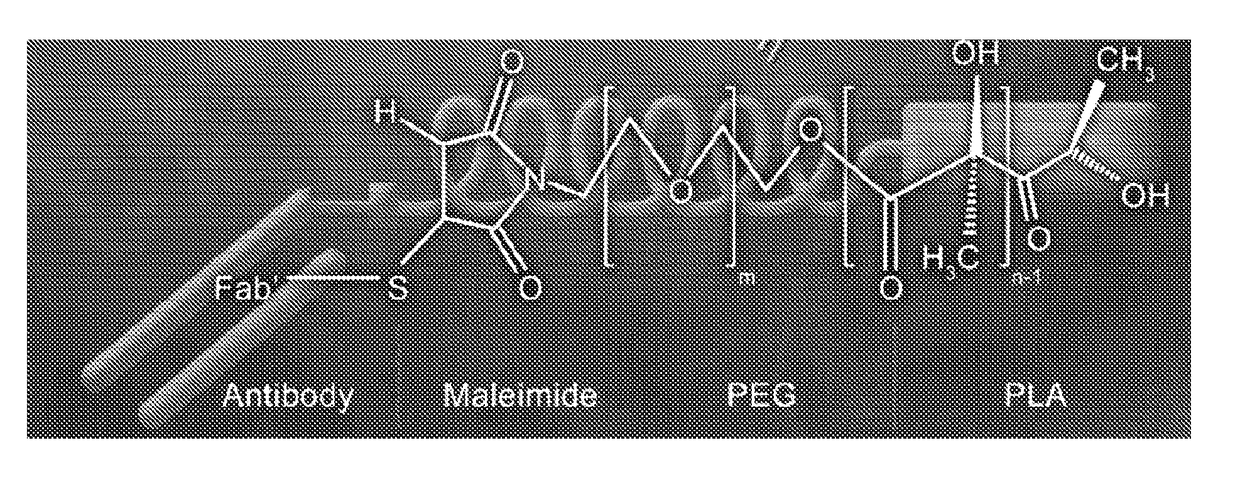Constructs for diagnosing and treating inflammatory bowel diseases and colon cancer
a technology for colon cancer and inflammatory bowel disease, which is applied in the field of construction for diagnosing and treating inflammatory bowel disease and colon cancer, can solve the problems of difficult delivery of drugs to the gastrointestinal tract, high side effects of most existing treatments, and high side effects, and achieves rapid mixing kinetics, improved endocytosis kinetics, and high loading concentration
- Summary
- Abstract
- Description
- Claims
- Application Information
AI Technical Summary
Benefits of technology
Problems solved by technology
Method used
Image
Examples
example 1
An F4 / 80-Coated TNFα siRNA-Loaded Nanoparticle
[0038]Two copolymer types were synthesized: maleimide-polyethyleneglycol-poly(lactic acid) and methoxypolyethyleneglycol-poly(lactic acid). Use of the first polymer permitted grafting of a mouse F4 / 80 antibody directly onto NPs, employing the functionality of maleimide, and the second polymer served in construction of an antibody-free control (a naked NP). Copolymer synthesis employed ring-opening polymerization in dry toluene under a moisture-free atmosphere of high-purity argon. The two copolymers were analyzed using H1NMR. The integrity of antibody grafted onto NPs was assessed by measurement of the interaction force between cells expressing F4 / 80 (Raw 264.7) and cells negative for F4 / 80 receptor expression (Caco2 BBE cells) using a Surface Plasmon Resonance (SPR) biosensor instrument.
[0039]Knowing the final concentration of F4 / 80 after reaction with the NPs and the average diameter of NPs measured by light scattering (375 nm), we det...
example 2
siRNA Anti-TNFα-Loaded Nanoparticles that Target Colonic Macrophages Offer an Effective Therapy for Experimental Colitis
[0041]In the study described below, we demonstrate that a therapeutic agent—an siRNA that targets TNFα—can be efficiently loaded into nanoparticles (NPs) made of PLA-PEG and that grafting of the targeting agent—an Fab′ portion of the F4 / 80 Ab—onto the NP surface via maleimide / thiol group-mediated covalent bonding improves the macrophage (MP)-targeting kinetics of the NPs to RAW264.7 cells in vitro. We observed direct binding between MPs and the antibody-bearing NPs. Next, we orally administered hydrogel (chitosan / alginate)-encapsulated antibody-bearing NPs loaded with TNFα siRNA to mice treated with 3% dextran sodium sulfate (DSS) and investigated the therapeutic effect on colitis. In vivo, the release of TNFα-siRNA-loaded NPs into the mouse colon attenuated colitis more strongly when the NPs were covered with the Fab′ portion of the F4 / 80 Ab, compared to uncovered...
PUM
| Property | Measurement | Unit |
|---|---|---|
| polydispersity index | aaaaa | aaaaa |
| diameter | aaaaa | aaaaa |
| diameter | aaaaa | aaaaa |
Abstract
Description
Claims
Application Information
 Login to View More
Login to View More - Generate Ideas
- Intellectual Property
- Life Sciences
- Materials
- Tech Scout
- Unparalleled Data Quality
- Higher Quality Content
- 60% Fewer Hallucinations
Browse by: Latest US Patents, China's latest patents, Technical Efficacy Thesaurus, Application Domain, Technology Topic, Popular Technical Reports.
© 2025 PatSnap. All rights reserved.Legal|Privacy policy|Modern Slavery Act Transparency Statement|Sitemap|About US| Contact US: help@patsnap.com



